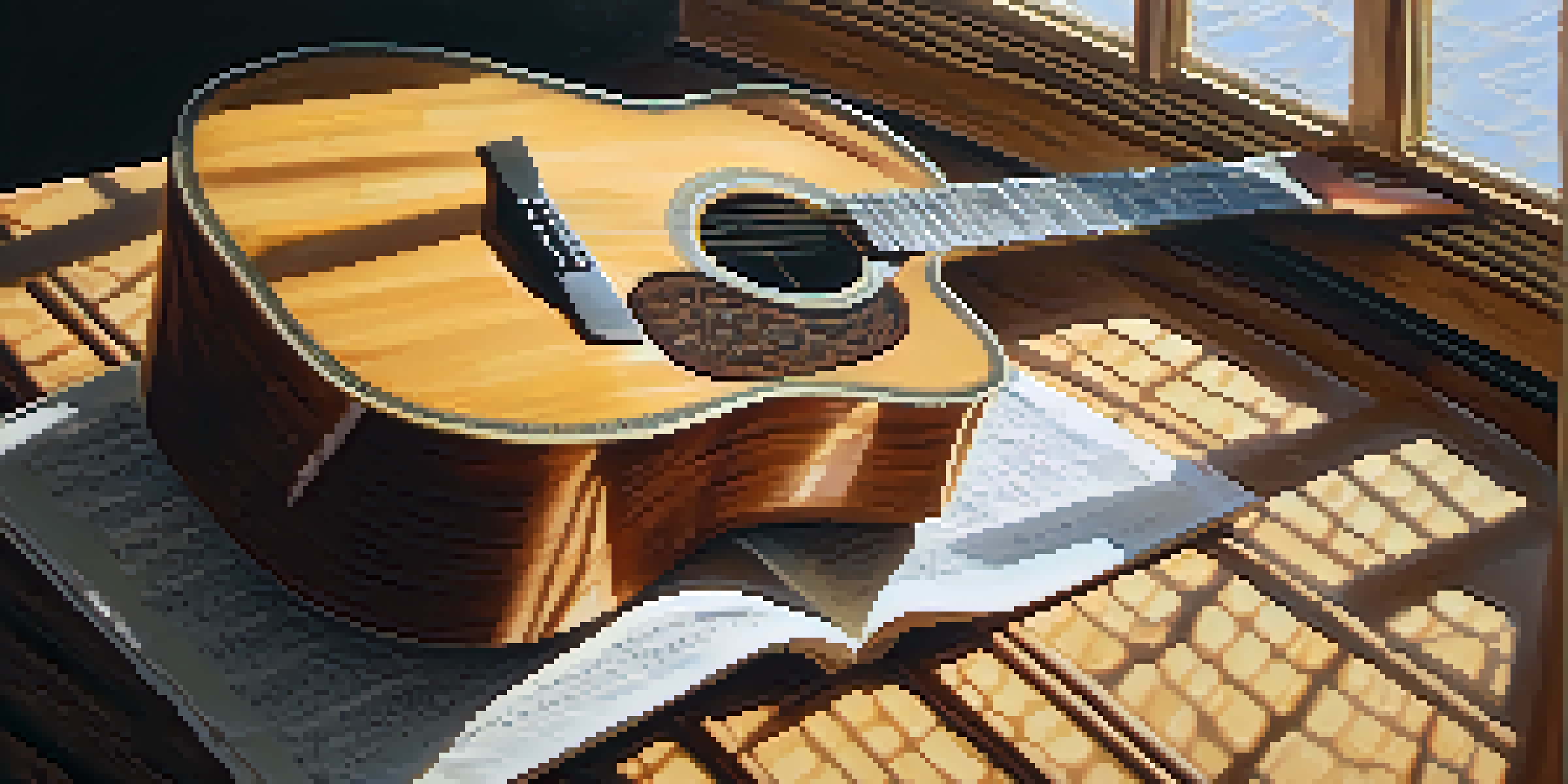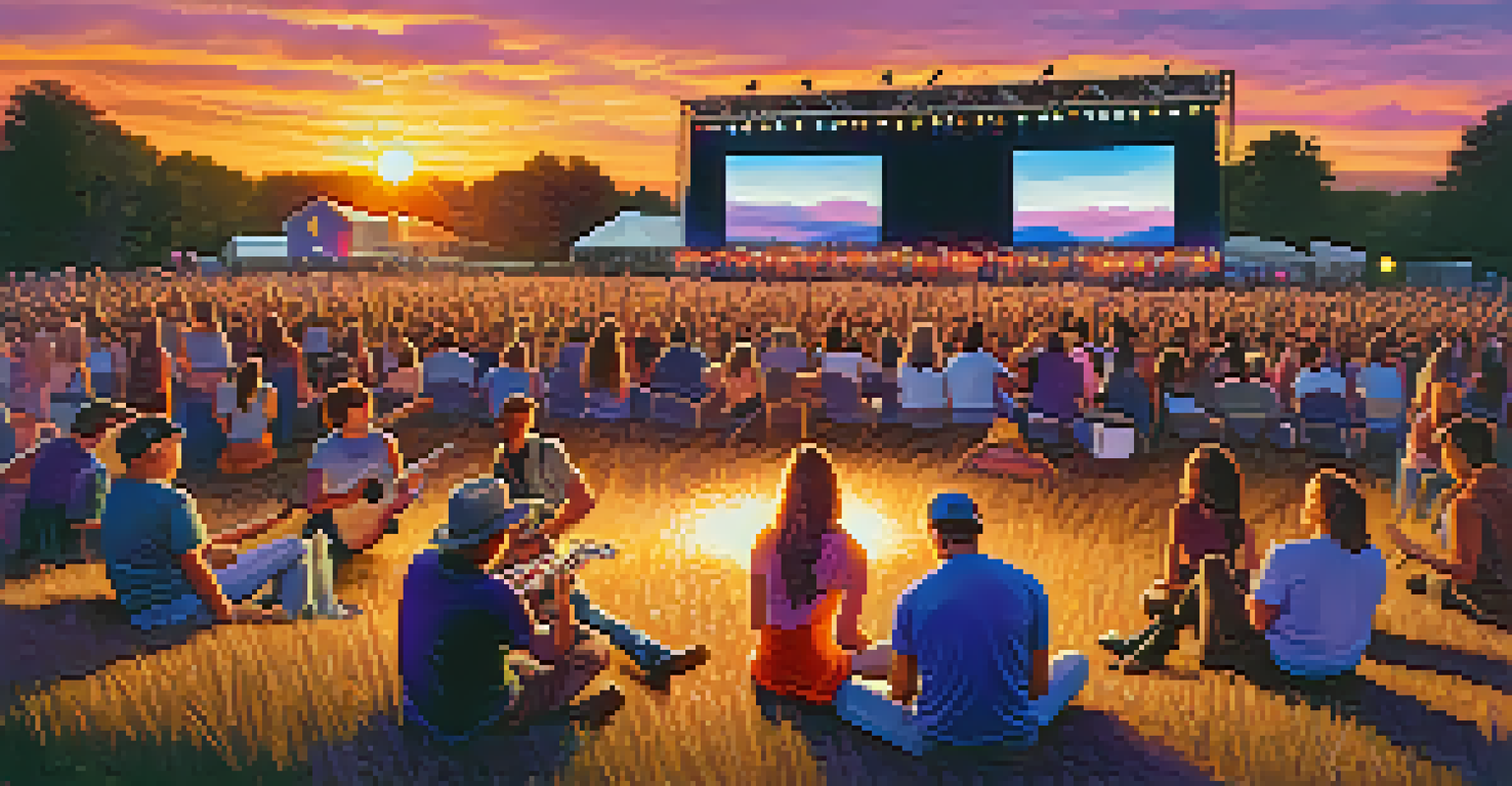The Development of Country Guitar Styles in Southern USA

The Roots of Southern Country Guitar: A Musical Heritage
Southern country guitar styles have deep roots, intertwined with the rich tapestry of American folk music. This genre has been shaped by influences from African American blues, Appalachian folk, and Spanish guitar traditions. Each of these styles contributed unique elements, forming a foundation that would evolve into what we recognize as country music today.
Country music is the perfect combination of the blues and folk, and the guitar is the heartbeat of that sound.
In the early days, guitarists employed simple strumming patterns, often accompanying ballads and storytelling songs that reflected the everyday lives of Southern communities. The use of open tunings and fingerpicking techniques began to emerge, showcasing the guitar as a lead instrument rather than just a rhythm provider. This shift allowed for greater expressiveness and personal style, which became essential in country music.
As the 20th century approached, the guitar's role expanded, leading to the rise of iconic figures who would shape the sound of country music. Legends like Maybelle Carter and Jimmie Rodgers started to popularize distinct playing styles, laying the groundwork for future generations of guitarists. Their innovations would set the stage for the diverse array of sounds that would follow.
The Birth of Bluegrass: A New Era for Country Guitar
The development of bluegrass music in the mid-20th century marked a significant evolution in country guitar styles. Pioneered by artists like Bill Monroe and Earl Scruggs, bluegrass emphasized intricate melodies and fast-paced rhythms, showcasing the guitar as a vital component of the ensemble. The incorporation of techniques such as flatpicking and improvisation allowed guitarists to shine in solo performances.

Bluegrass guitarists often utilized a mix of traditional folk elements and jazz influences, creating a unique sound that resonated with audiences. This genre also encouraged competition among musicians, pushing players to refine their skills and develop signature styles. The iconic sound of the banjo, mandolin, and fiddle complemented the guitar, resulting in a rich musical dialogue.
Southern Roots Shape Country Guitar
The rich influences of African American blues, Appalachian folk, and Spanish guitar traditions have formed the foundation of country music guitar styles.
As bluegrass gained popularity, it inspired a new wave of guitarists eager to experiment and innovate. This period saw the emergence of influential players like Doc Watson, who brought a fresh perspective to guitar playing, integrating folk and blues influences into the bluegrass framework. Their contributions solidified the guitar's place in this vibrant musical landscape.
Honky-Tonk and the Electric Guitar Revolution
As country music evolved through the 1940s and 50s, honky-tonk emerged as a prominent subgenre, characterized by its lively barroom atmosphere and relatable lyrics. The introduction of the electric guitar transformed the sound of country music, allowing for greater volume and sustain. This change attracted a new generation of guitarists who were eager to embrace the electrifying possibilities of the instrument.
The guitar is a tool for storytelling in country music, capturing the essence of life's highs and lows.
Artists like Hank Williams and Lefty Frizzell were at the forefront of this movement, blending traditional country sounds with the energy of electric guitar riffs. Their music resonated with audiences, and the honky-tonk style became synonymous with post-war American culture. The electric guitar allowed for expressive solos and a more dynamic stage presence, further popularizing the genre.
With the rise of honky-tonk, guitarists began to experiment with various effects and techniques, such as slide guitar and fingerpicking. This innovation led to a distinctive sound that characterized the honky-tonk movement, allowing artists to showcase their technical skills and creativity. The electric guitar's impact reshaped the landscape of country music, paving the way for future styles.
The Influence of Outlaw Country on Guitar Styles
In the 1970s, outlaw country emerged as a rebellious response to the polished Nashville sound, bringing with it a fresh approach to guitar playing. Artists like Willie Nelson and Waylon Jennings embraced a raw, authentic style that resonated with fans seeking a more genuine musical experience. This movement emphasized storytelling and personal expression, with guitarists often showcasing their unique interpretations.
Outlaw country guitarists drew inspiration from rock and roll, blues, and folk, creating a diverse sound that defied traditional genre boundaries. This fusion allowed for more freedom in songwriting and performance, encouraging musicians to experiment with their guitar work. The incorporation of electric guitars, along with country staples like the acoustic guitar, created a rich sonic palette.
Bluegrass Revolutionizes Guitar Play
The emergence of bluegrass in the mid-20th century introduced intricate melodies and techniques like flatpicking, highlighting the guitar's important role in the genre.
The outlaw country movement also paved the way for a new generation of guitarists to emerge, including artists like Steve Earle and Sturgill Simpson. Their willingness to challenge conventions and explore new musical directions continues to influence contemporary country guitar styles today. The spirit of outlaw country remains alive, encouraging authenticity and innovation in the genre.
The Rise of Alternative Country and Indie Influences
As we moved into the late 20th century, alternative country began to gain traction, blending traditional country elements with influences from punk, rock, and folk. This genre allowed for more experimental guitar work, with artists like Uncle Tupelo and Wilco pushing the boundaries of what country music could be. Their use of unconventional song structures and diverse instrumentation broadened the scope of country guitar styles.
Alternative country guitarists often embraced a lo-fi aesthetic, reflecting a more grassroots approach to music-making. This movement encouraged musicians to explore personal narratives and emotional depth in their songwriting, resulting in a more introspective sound. The guitar became an essential tool for conveying these themes, with players experimenting with different techniques to enhance their storytelling.
The influence of indie rock also brought a new wave of guitarists to the forefront, incorporating elements like feedback, distortion, and complex chord progressions. This fusion of genres created a rich tapestry of sound that resonated with a diverse audience, expanding the definition of country music. As alternative country gained popularity, it inspired countless artists to carve their own paths in the evolving landscape of Southern music.
Modern Country Guitar: Blending Genres and Styles
Today, modern country guitar styles reflect a melting pot of influences, blending elements from pop, rock, hip-hop, and even electronic music. Artists like Kacey Musgraves and Maren Morris are at the forefront of this evolution, incorporating diverse sounds while remaining rooted in traditional country. This genre-blurring approach has redefined what it means to be a country artist in the 21st century.
With advancements in technology, guitarists now have access to an array of effects and production techniques that allow for greater creativity. The use of looping pedals, synthesizers, and digital effects has opened new avenues for expression, enabling musicians to create unique soundscapes. This modern toolkit empowers artists to push the boundaries of country music while maintaining its core essence.
Modern Country Blends Diverse Sounds
Today's country guitar styles fuse elements from pop, rock, and hip-hop, allowing artists to innovate while staying connected to traditional roots.
As a result, contemporary country guitar styles continue to evolve, driven by a new generation of musicians who are unafraid to experiment and innovate. The genre's adaptability ensures that it remains relevant and resonant, connecting with audiences across various backgrounds. Ultimately, the evolution of country guitar reflects the vibrant and ever-changing landscape of Southern music.
The Future of Country Guitar: Trends and Innovations
Looking ahead, the future of country guitar styles is poised for continued evolution, fueled by technological advancements and shifting cultural influences. With the rise of social media platforms like TikTok, emerging artists can showcase their guitar skills to a global audience, democratizing the music industry. This accessibility is encouraging a new wave of creativity, as musicians draw inspiration from diverse genres and styles.
Additionally, as the world becomes more interconnected, the fusion of international musical influences is likely to play a significant role in shaping future country guitar sounds. Collaborations between artists from different backgrounds are already becoming more common, leading to innovative approaches that challenge traditional boundaries. This cultural exchange is enriching the genre, infusing it with fresh perspectives and ideas.

In conclusion, the development of country guitar styles in the Southern USA has been a dynamic and evolving journey. From its roots in folk traditions to the modern genre-blending sounds of today, the guitar remains a central instrument in this rich musical landscape. As artists continue to innovate and inspire, the future of country guitar promises to be as vibrant and diverse as its storied past.